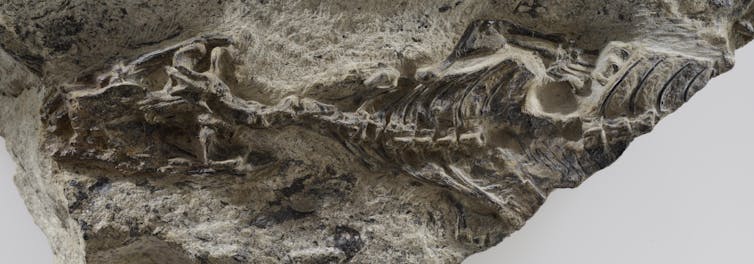Ancient fossil fills a 75 million-year gap and rewrites lizard and snake history
- Written by Alessandro Palci, Research Associate in Evolutionary Biology, Flinders University
Australia is famous for its many lizards and snakes, but where do they all come from?
Published today in Nature, a new analysis of an ancient fossil found in the Italian Alps has helped us shed light on their origin.
It turns out that Megachirella, an intriguing little fossil reptile about the size of a bluetongue skink, is the ideal intermediate between modern lizards and their closest relatives, a broad group of reptiles that includes today’s tuataras from New Zealand.
Read more: Not a lizard nor a dinosaur, tuatara is the sole survivor of a once-widespread reptile group
Only once in a blue moon is a fossil discovered that has a profound impact on our understanding of how major animal groups originated and evolved.
Perhaps the most famous example is that of the feathered dinosaur Archaeopteryx, found in Bavaria in 1861, which links dinosaurs and birds. That fossil was used by Charles Darwin himself to support his theory of evolution via natural selection.
So how was the fossil of Megachirella discovered?
The history of the fossil
It was found in the Italian Dolomites in 240 million-year-old rocks that are thought to have originated on the bottom of a warm, shallow sea. The fossil is one of very few terrestrial organisms that were entombed in those marine sediments, which makes its discovery incredibly fortuitous.
Shortly after its discovery, in 2003, the fossil was described by Italian scientists Silvo Renesto and Renato Posenato. They named it Megachirella after its relatively large hands: “mega” and “cheiros” are ancient Greek words for “large” and “hand”, respectively.
They then proceeded to classify the fossil as a member of the Lepidosauromorpha, a broad group of reptiles that includes lizards, tuataras, and many other more distantly related reptiles.
 The re-study of this beautifully preserved specimen of Megachirella allowed the authors to re-write the history of all fossil and living lizards and snakes.
MUSE - Science Museum, Trento, Italy, Author provided
The re-study of this beautifully preserved specimen of Megachirella allowed the authors to re-write the history of all fossil and living lizards and snakes.
MUSE - Science Museum, Trento, Italy, Author provided
Ten years later, in 2013, Megachirella was redescribed in a study by Renesto and Massimo Bernardi. They confirmed the classification of Megachirella as a lepidosauromorph based on a more sophisticated computer-generated comparison with other species (phylogenetic analysis).
New insights from old bones
But the fossil was recently scanned at the ICTP Elettra synchrotron facility in Trieste, Italy. This revealed a whole new suite of anatomical features that place Megachirella in a different and much more interesting light.
Thanks to the most advanced technologies, including high-resolution computer tomography, our international team of researchers could have a closer look at the details of the anatomy of Megachirella than was ever possible before.
These three-dimensional digital images allowed us to look through the rock, at parts of the skeleton that were previously inaccessible, without damaging this unique fossil by removing the embedding rock mechanically.
The story behind the discoveries. MUSE - Science Museum, Trento, Italy.What we discovered was that Megachirella possesses the light flexible skull and distinct limb bones that characterise modern lizards. But it also still retains some extra bones that were common in early reptiles.
After we included this new information in a phylogenetic analysis, it turned out that Megachirella is a lizard. In fact, it’s the oldest and most primitive lizard known to date.
Evolution of a lizard
Megachirella helps us understand how the anatomy of earlier reptiles gradually changed over time, in little steps, to produce the body shape of lizards that is familiar to us today.
This represents yet another important piece in the fascinating puzzle of evolution. It lends further support to Darwin’s theory that organisms are not immutable, but actually transform and adapt, generation after generation, over long periods of time.
Megachirella is important because - like Archeopteryx - its anatomy bridges the gap between two major groups of animals. It also greatly extends the fossil record of lizards, by about 75 million years, into the middle Triassic around 240 million years ago.
That lizards must have been present around the time of the first dinosaurs had been predicted by some molecular studies of living lizards. This is based on the speed at which DNA strands accrue mutations over time (the rate of evolution).
But the oldest known fossil lizards before Megachirella were frustratingly “young”, coming from rocks that originated in the Jurassic period, only about 167 million years ago.
This fossil gap might be due to several reasons, such as the paucity of rock outcrops of the right age and sedimentary environment (most Triassic rocks exposed today were formed in the ocean), and the fragile nature of lizard skeletons. Sometimes it is difficult even to recognise lizard fossils for what they are, especially when their remains are very fragmentary.
Megachirella tells us that lizards were indeed around in the Triassic period. Based on a new estimate of the rate of evolution of lizards, we can now place the origin of these reptiles in the late Permian period, about 260 million years ago.
This is just before the greatest mass extinctions of all time. This means that lizards survived a mass extinction that wiped out more than 70% of life on Earth.
Authors: Alessandro Palci, Research Associate in Evolutionary Biology, Flinders University



